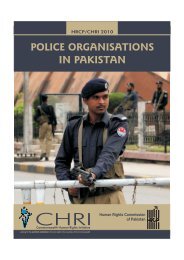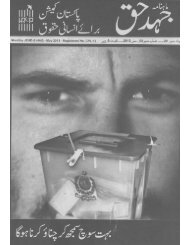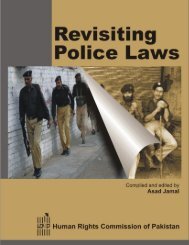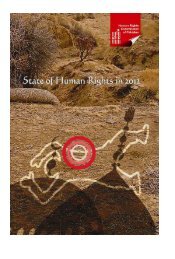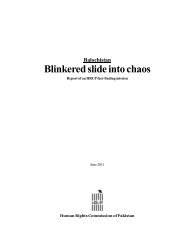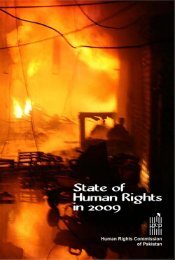Download PDF file - HRCP
Download PDF file - HRCP
Download PDF file - HRCP
Create successful ePaper yourself
Turn your PDF publications into a flip-book with our unique Google optimized e-Paper software.
<strong>HRCP</strong> fact-finding missions’ report 39<br />
Indicators Balochistan Pakistan<br />
Literacy 26.6% 47%<br />
(Female) (15%) (33%)<br />
Primary School Enrolment 49% 68.3%<br />
(Female Participation) (21%) (49.2%)<br />
Access to Sanitation 7% 18%<br />
Infant Mortality Rate<br />
(Per 000’LB) 108 100<br />
Village Electrification 25% 75%<br />
Access to Safe Drinking Water 20% 86%<br />
Source: Report of the Parliamentary Committee on Balochistan (Nov. 2005).<br />
(SPDC) in 2005, the incidence of poverty is much higher in Balochistan than any other province. On average<br />
48 percent people are living below poverty line. The condition in rural areas is worse as 51 percent population<br />
does not have proper food, clothing and shelter. Moreover they do not have access to pure water, health and<br />
education.<br />
According to the 1988 census Balochistan had a population of 6,511 million in an area of 347,190 km.<br />
The population density is 19 persons/km making development, particularly of building infrastructure, more<br />
difficult and expensive. The table below shows some of the social indicators:<br />
Federal structure of Pakistan<br />
Since its inception, and particularly on the basis of the 1973 constitution, Pakistan has been a federal<br />
state with a parliamentary system. Due to numerous disruptions during democratic transitions, by way of<br />
military coups, a number of distortions have crept in, making its system very centralized and practically unitary<br />
in nature. The military has held most power in this set-up.<br />
In such systems, the principles of separation of powers and a structure of federalism remain seriously<br />
undermined. Despite a feeble attempt at creating a parliamentary system, there remains little doubt that<br />
decisionmaking is in the hands of the military. The expression ‘unity of command’ is often used by military<br />
leaders. Punjabis dominate the population of Pakistan and the ethnic composition of the military, and thus the<br />
overwhelming impression in Balochistan is that the military and Punjab’s establishment run the country to fulfill<br />
their stakes. Baloch nationalists also argue that Balochistan was given a step-motherly treatment even during<br />
the brief periods of transitional democracy. They lament that even the Constitutional guarantees,(though<br />
inadequate), have not been respected by the Federal government.<br />
The Constitution of Pakistan distributes powers between the Federation and the Provinces. The federal<br />
parliament has an upper and a lower House. In the latter there is representation on the lines of population while<br />
the composition of the former is based on the principle of provincial parity. 15 In addition to this, the Constitution<br />
gives two lists of subjects, the Federal and Concurrent. The Federal Parliament has powers over matters



